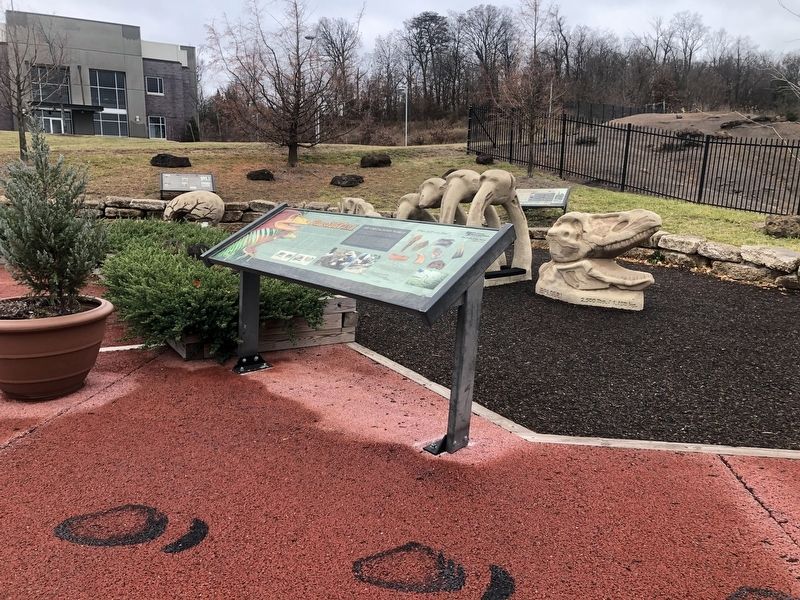Near Laurel in Prince George's County, Maryland — The American Northeast (Mid-Atlantic)
Welcome to Dinosaur Park
Welcome to the most productive dinosaur fossil quarry east of the Mississippi River. From the bones and teeth of the Maryland State Dinosaur Astrodon ohnstoni to the remains of early flowering plants, the fossils found at Dinosaur Park hep scientists reconstruct our region's ancient history.
In 1858, African American iron miners working in this site discovered the first Maryland dinosaur fossils. Later, famed 19th-century paleontologist John Bell Hatcher would recover many more fossils; including bones and teeth from six dinosaur species. Fossils are still found at Dinosaur Park today. Since 2009, this irreplacable natural resource has been preserved for scientific study and public educational programs.
Dinosaur Park is a cooperative project between the Maryland-National Captial Park and Planning Commission and Jakson-Shaw, developer of The Bick Yard. The Park serves as an outdoor laboratory where the public can work alongside paleontologists to help uncover and interpret the past.
The Cretaceous World
The fossils at Dinosaur Park were deposited during the Cretaceous Period, which lasted from 145 to 66 million years ago. This is relatively recent history compared to the 4.5 billion year age of the Earth. Still, it is much older than the marine fossils of the nearby Calvert Cliffs (20 million years old), or the earliest humans (200 thousand years old).
In many ways, the Cretaceous Period marked the birth of the modern world. during this time, the northern and southern landmasses of the Jurassic Peirod began to break up, forming the mosaic of continents and oceans we know today. The expanding oceans influenced the global climate, which became cooler and drier, with more pronounced seasons. This in turn led to the expansion of temperate forests, with trees such as oak, hickory, and magnolia gaining prominence throughout North America. Meanwhile, flowering plants first became widespread in the Cretaceous Period, oined by the first pollinating insects. The fossils found at Dinosaur Park help scientists understand how and why these important environmental transitions took place.
An Ancient River
110 million years ago, central Maryland was a flat coastal plain with winding rivers. Sharp bends in the rivers became detached and formed lakes or swamps called oxbows. Dinosaur Park is a remnant of one such oxbow. When the river was high, debris drifting downstream, including dead plants and animals would flow into the oxbow, and become trapped there when the flood waters receded. There they were entombed in clay and became the fossils we find at Dinosaur Park today.
What will you find?
[Captions:]
These
In 2006 Smithsonian specialists excavated this dinosaur tibia (leg bone).
Erected by Maryland-National Capital Parks and Planning Commission.
Topics. This historical marker is listed in these topic lists: African Americans • Animals • Industry & Commerce • Paleontology. A significant historical year for this entry is 1858.
Location. 39° 4.25′ N, 76° 52.122′ W. Marker is near Laurel, Maryland, in Prince George's County. Marker is on Mid Atlantic Boulevard, 0.4 miles south of Contee Road when traveling west. Touch for map. Marker is at or near this postal address: 13100 Mid Atlantic Blvd, Laurel MD 20708, United States of America. Touch for directions.
Other nearby markers. At least 8 other markers are within walking distance of this marker. The Dinosaurs of Dinosaur Park (a few steps from this marker); Meet Astrodon johnstoni (a few steps from this marker); The Industrial Heritage of Dinosaur Park (a few steps from this marker); a different marker also named Welcome to Dinosaur Park (a few steps from this marker); George Washington Carver (approx. 0.4 miles away); Veterans Memorial (approx. 0.4 miles away); Three Sisters: Close Knit Communities of the Laurel Area (approx. 0.8 miles away); Abraham Hall: An African American Benevolent Lodge (approx. 0.8 miles away). Touch for a list and map of all markers in Laurel.
Related marker. Click here for another marker that is related to this marker. This marker has replaced the linked marker.
Credits. This page was last revised on December 11, 2021. It was originally submitted on December 11, 2021, by Devry Becker Jones of Washington, District of Columbia. This page has been viewed 240 times since then and 53 times this year. Photos: 1, 2. submitted on December 11, 2021, by Devry Becker Jones of Washington, District of Columbia.

